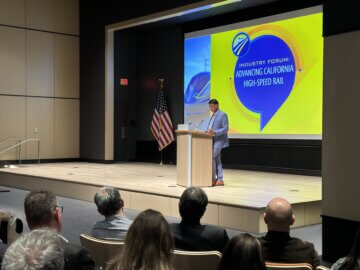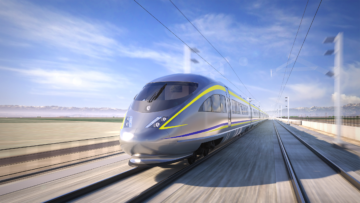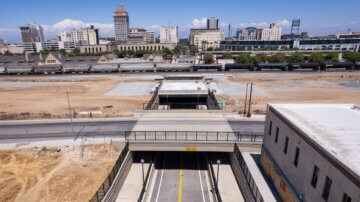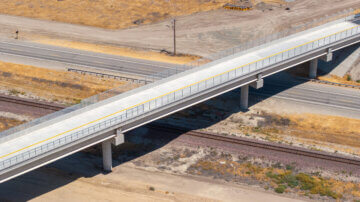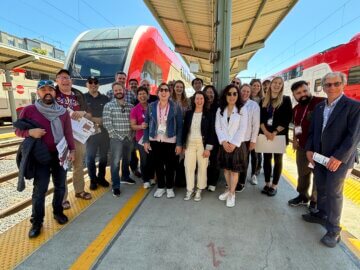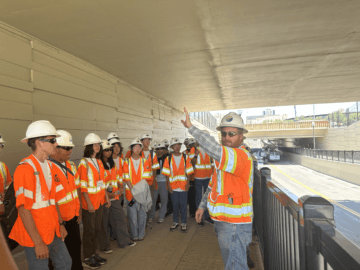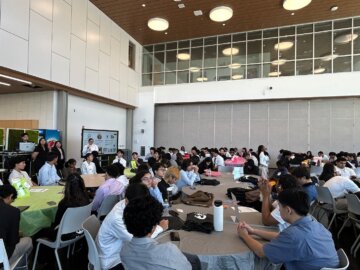|
主要ニュース |
パートナーの最新情報 |
アウトリーチの最新情報 |
カリフォルニア州、高速鉄道への安定した資金提供協定を締結
9月19日、ギャビン・ニューサム知事は、州議会と交渉し、キャップ・アンド・インベスト・プログラムを再認可し、2045年まで毎年1兆5千億1000万ドルをカリフォルニア高速鉄道公社(以下、公社)に提供するという歴史的な約束を交わし、署名しました。これは、同プログラムのために確保された保証資金としては、これまでで最大の額となります。
イアン・チョウドリ最高経営責任者(CEO)は、この合意を「カリフォルニアの将来についての大胆な宣言であり、雇用を創出し、汚染を削減し、州全体のコミュニティを結びつけ、変革するもの」と呼んだ。
これにより、高速鉄道プロジェクトは安定的かつ予測可能な資金調達源を確保し、より確実な計画立案と効率的なプロジェクト遂行が可能になります。また、資金の保証により、民間資本の誘致能力が向上し、既存資金を先行的に活用することで、プロジェクトの納期を短縮し、長期的なコストを削減することが可能になります。
この最低限の資金レベルと15年間の延長により、セントラルバレーのマーセドからベーカーズフィールドまでの区間の建設費用が賄われ、資金不足は事実上解消されることになる。
イアン・チョードリCEO、初年度の高速鉄道に関する新たなビジョンを発表
2024年8月、当局の取締役会は、プログラムの計画段階から運用段階への移行を担う新CEOとして、イアン・チョウドリ氏を選出することを承認しました。就任以来、チョウドリ氏は当局をよりビジネスに近い形で運営できるよう組織再編を行い、効率性、説明責任、そして迅速な実行を確保してきました。就任1年目、チョウドリ氏は州内各地の交通関係者や地域パートナーと連携し、プログラムの新たな方向性について協議を重ねてきました。これらの変革を通して、チョウドリ氏は当局がより迅速、スマート、そして経済的なサービス提供に向けた大胆な新たな道を歩んでいることを示すことで、民間セクターを含む世界中の人々から支持と関心を集めています。以下に、これまでの取り組みのハイライトをいくつかご紹介します。
2025年のスタートにあたり、当局は2日間にわたる業界フォーラムを開催し、鉄道システム、建設、設計、技術、金融の各企業を代表する400名以上の参加者を得て、大変盛況でした。専門家やイノベーターが全国各地、そして一部は海外からも当局と会合し、貴重なフィードバックを提供し、重要な意思決定の参考にし、プロジェクトの将来像を形作っています。当局は、今後の調達戦略の策定にあたり、民間セクターからのフィードバックと助言を継続的に求めていきます。これには、調達に関する報告書の発行も含まれます。 関心表明のお願い この春、高速鉄道プロジェクトの優先実施戦略の商業、財務、技術、調達の側面について協議しました。
5月、チョードリCEOはワシントンD.C.で開催された全米高速鉄道協会(USHRA)年次総会に出席し、全国的な注目を集めました。「南西部におけるアメリカ初の真の高速鉄道システムの推進」と題したプレゼンテーションでは、プログラム目標の進捗状況、そしてブライトライン・ウエスト社およびハイ・デザート・ジョイント・パワーズ・コリドー社との合意について説明しました。この合意は、当社の高速鉄道システムと同社の高速鉄道システムを接続することで、全米初の州間高速鉄道網を構築するものです。
6月、チョードリCEOはサンフランシスコで開催された米国公共交通協会(APTA)主催の高速鉄道セミナーで基調講演を行いました。開発・投資会社の幹部らと共に、国際的な旅客鉄道関係者を対象としたパネルディスカッション「高速鉄道における官民パートナーシップ(PPP)の意義」に出席しました。パネルディスカッションでは、PPPがプログラムセグメントの迅速かつ効率的な実施を支援すると同時に、列車編成、駅施設、線路アクセス、光ファイバー、不動産といった資産の商業化を促進する上でもたらすメリットについて議論されました。
チョードリCEOは、州内外のメディア関係者と、地方レベルおよび州全体における高速鉄道の今後の取り組みについて協議を重ねてきました。サンノゼ・マーキュリー・ニュースの最近の記事 ここに そして ここにフレズノ・ビー紙の肯定的な論説 ここに, ここに、そして ここに、長文記事 フォーブス, KTLA, ストリートブログ、 そしてその サンフランシスコ・クロニクル これは、プロジェクトの新たな方向性を一般の人々と共有するというチョードリ氏の決意を示すものです。
新たなリーダーシップのもと、高速鉄道の新たなビジョンが生まれました。CEOのチョードリー氏は、この革新的なビジョンを伝えるため、州内および全米各地を視察し、市民、メディア、そして重要なステークホルダーと積極的に交流してきました。新たな活力と新たな視点で、このプログラムは、カリフォルニア州民全員に近代的でクリーンな交通システムを提供するために前進を続けています。
当局は2026年の鉄道敷設のスケジュールを前倒し
8月28日、高速鉄道当局の理事会は、高速鉄道の線路およびその他必要なシステムコンポーネントの提供に関する入札公告の発行を承認しました。これは、来年開始予定の線路およびシステムの建設を加速させる重要な節目となります。この承認により、カーン郡における南部鉄道拠点プロジェクトの完成が近づく中、米国のメーカーは6つの個別の調達において競争入札を行う道が開かれます。
119マイル区間の線路敷設に必要な資材は、すべて州政府が全額負担します。レール、枕木、架空電車線路柱、光ファイバーケーブル、ENバラストなど、様々な資材が含まれます。承認された総費用は1億5,507万トンで、複数の契約締結を予定しています。すべての資材は新規に製造され、「バイ・アメリカ」法および「ビルド・アメリカ・バイ・アメリカ法」に準拠しています。入札募集は2025年8月以降に開始される予定です。 このアクションの詳細については、こちらをご覧ください。.
当局がさらに2つの建物を完成
当局は夏の間、2 つの建造物を完成させ、今年度の完成数は 7 つとなり、建設開始以来セントラル バレー地域で完成した建造物は 60 近くに達しました。
8月21日、トゥーレア郡でアベニュー88の立体交差が完成しました。ドラガドス・フラットアイアン・ジョイントベンチャー社が建設したこの立体交差は、農機具、緊急対応要員、そして車両のアクセス向上に役立ちます。州道43号線付近に位置するこの立体交差は、長さ485フィート(約145メートル)、幅32フィート(約9メートル)以上です。 この構造の詳細については、こちらをご覧ください。.
7月下旬には、フレズノ市当局と地元および州の指導者たちが、テューレア通り立体交差事業の完了を祝い、フレズノのヒストリック・チャイナタウンでテープカット式典を開催しました。この立体交差により、車両はユニオン・パシフィック鉄道と将来敷設される高速鉄道の線路下20フィート以上を走行できるようになりました。全長1,000フィート、幅60フィートを超える2車線道路となり、歩行者用レーンと自転車レーンが整備され、住民や自転車利用者の安全性向上と温室効果ガス排出量の削減に貢献します。この事業は、数十年にわたり分断されていたフレズノのチャイナタウンとダウンタウンを再び繋ぎ、アクセスとモビリティの向上、長期的な経済成長の促進、そして高速鉄道建設の基盤整備という点で、特に意義深いものです。 この構造の詳細については、こちらをご覧ください。.
| パートナーアップデート |
北カリフォルニアにおけるパートナーシップと進歩
サンフランシスコで開催された2025年アメリカ公共交通協会(APTA)鉄道会議では、2回の別々のツアーで世界中の交通幹部が高速鉄道プロジェクトを直接体験し、パートナーシップと進歩が披露されました。
土曜日の午前中、公共交通指向型開発に関するツアーがセールスフォース・トランジット・センターを訪れました。ツアーでは、既に建設済みの地下のトレインボックス、カリフォルニア高速鉄道とカルトレインの将来の終点、そしてその周囲に広がる約19エーカーの住宅、商業施設、オープンスペースなどを見学しました。この地域は、トランスベイ・プログラムと呼ばれる野心的な計画・開発プロジェクトによって変貌を遂げてきました。
ツアーを率いたのは、サンフランシスコの高速鉄道の将来拠点となるトランジットセンターを所有・運営するトランスベイ共同権限局(TJPA)のエグゼクティブディレクター、アダム・ヴァン・デ・ウォーター氏だ。
ヴァン・デ・ウォーター氏は、これを「国内で最も成功した公共交通指向型開発の一つ」と呼び、「過去20年間、TJPAとそのパートナーは、広大な駐車場と高速道路ランプを、9つの交通事業者と数百万平方フィートの新規開発によってサンフランシスコで最も刺激的な新しい地区へと変貌させ、現在では1万5000人以上の新規居住者が暮らしています」と説明した。
同日遅く、会議参加者25名が新たに電化されたカルトレインに乗車し、将来の高速鉄道北端ターミナルとなるマルチモーダル・セールスフォース・トランジットセンターを視察しました。カルトレイン路線の電化に当局が投資した157億トン以上は、このプロジェクトの資金調達と、将来の高速鉄道サービスに向けた路線整備に役立っています。
カルトレイン近代化プログラムのディレクター、シェリー・ブロック氏は、そのメリットについて次のように説明した。「電化により、インフラを安全に共有できるようになります。加速性能の向上、停車時間の短縮、運行頻度の向上により、路線容量が増加します」と彼女は説明し、同時に排出量も削減できると付け加えた。「これは、カルトレインだけでなく、カリフォルニア全土における統合型近代鉄道の未来にとって、大きな節目となるでしょう。」
ツアーは4時に始まりましたth キング駅を出発し、ミルブレー駅まで乗車しました。ハイライトは、サンフランシスコにある歴史ある100年前のトンネル4本と、ブリスベンに建設予定の北カリフォルニア軽便保守施設でした。参加者は、様々な種類の踏切、サンフランシスコ国際空港周辺の複雑なインフラ、そして駅周辺に建設中の新しい住宅について説明を受けました。HNTB社のジョン・リッツィンガー氏は、説明と議論において専門知識を提供しました。
| アウトリーチの最新情報 |
交通学科の学生が高速鉄道のハイライトを見学
「時速約357マイルという高速鉄道の最速記録はどこで樹立されたのですか?」ミネタ夏季交通アカデミー(MiSTA)の学生数名が、ためらうことなく答えました。「フランス:TGVです。」
セントラルバレー全域で建設中のカリフォルニア州高速鉄道プロジェクトの構造物を見学する高校生たちを見れば、将来の交通リーダーとなる彼らが高速鉄道に熱意を持っていることがよく分かります。
このツアーは、サンノゼ州立大学ミネタ交通研究所(MTI)が交通および関連分野に興味のある学生を対象に実施する3週間の実践型プログラムの一環です。MTIの主な特徴は、空港や鉄道駅といった交通インフラやシステムの舞台裏見学です。
ドイツの鉄道会社ドイツ鉄道(DB)のダニエル・ハイネ氏は、7月16日、サンノゼ発のバスの中で28名の学生に説明を行い、セントラルバレー建設ツアーの幕開けを告げました。DBはセントラルバレー鉄道公社(DB)の早期運行事業者であり、戦略的な列車運行計画やシステム統合などの業務を担っています。ハイネ氏は学生たちに技術面と政策面の課題について説明し、鉄道運行の安全性と高速鉄道の環境面での利点を強調しました。
フレズノ市当局の広報担当官オージー・ブランカス氏が現地視察と説明を主導し、「私たちは現在も建設工事が行われている現場を訪問します。安全は常に最優先事項です」と学生たちに注意を促しました。各訪問地点の前に、安全に関する説明が繰り返し行われました。
その後、学生たちはフレズノ中心部の地下を走るテューレア・ストリート地下道へ降り、南東にあるシーダー・ビアダクトの頂上を訪れました。地下道では、当局職員が学生たちにコンクリート建設に用いられる技術と地下構造物における排水の重要性について説明しました。
ツアーのハイライトは、全長3,700フィート(約1,100メートル)、幅40フィート(約12メートル)を超えるシーダー高架橋の登頂でした。説明会では、建設の歴史や設計の詳細、そしてこのような巨大なインフラを登るための安全対策について説明されました。
2025 年のアカデミーは、都市間旅客鉄道および貨物鉄道の安全性、効率性、信頼性の向上に特化した FRA の統合鉄道インフラストラクチャおよび安全性改善 (CRISI) 助成金プログラムによって資金提供されました。
「学生たちには、エンジニア、プランナー、アウトリーチ・コミュニケーション担当者から直接、巨大インフラプロジェクトの建設に関わるあらゆることを学んでほしいと考えています」と、MTIのオペレーションディレクター、アルヴェリーナ・ワイナーディ氏は述べています。「高速鉄道の建設の舞台裏を学生たちに見せることで、私たちの移動や暮らしを形作る交通関連のキャリアを目指す次世代の人材を育成したいと考えています。」
南カリフォルニアアウトリーチのまとめ
K12フットヒルコンソーシアム高校インターンシップ学生プロジェクトオンボーディングツアー
この夏、南カリフォルニア チームは、チャーター オーク、モンロビア、ドゥアルテ、アズサ統合高校学区の K12 フットヒル コンソーシアム高校のインターン生を、夏季学生プロジェクトの一環として当局との初のオンボーディング ツアーに迎えました。
旅はロサンゼルス鉄道遺産財団のCOO、ジャレッド・ニグロ氏の案内で、ロサンゼルス・ユニオン駅(LAUS)の見学から始まりました。ニグロ氏は、同駅の豊かな歴史とカリフォルニアの鉄道遺産における役割について説明しました。その後、学生たちはLAUSの向かいにある歴史あるフレンチディップレストラン「フィリップ・ジ・オリジナル」で昼食をとり、鉄道局の最新展示を見学しました。列車展示室の展示を鑑賞しながら、学生インターン生が学生プロジェクトの一環として鉄道局職員と共同でデザインした、9月にデビュー予定の改装工事に協力しました。一日の締めくくりは鉄道局の南カリフォルニア事務所で行われ、学生たちは州全体にわたるプロジェクトと多様なキャリア機会について学びました。 これらの学生のプロジェクトの詳細については、ここをクリックしてください。.
ロサンゼルス公共図書館就職フェア
この夏、ロサンゼルス公共図書館で開催されたジョブフェアで、SoCalチームはカリフォルニア州の高速鉄道プロジェクトについて知りたいという50人以上の求職者と交流しました。当局職員はプロジェクトの進捗状況を報告するとともに、熟練工を目指す人々のためのキャリアパスや機会について話し合いました。当局はセントラルバレー・プレアプレンティスシップ・トレーニング・プログラムを通じて利用可能な機会についても共有し、参加者は高速鉄道における将来のキャリア機会について学ぶことに熱意を燃やし、キャリアパスについて多くの質問をしました。このイベントは参加者の熱意を高め、地域社会がプロジェクトについて、そして州の交通環境における歴史的な変革の一翼を担うための準備方法についてより深く理解するきっかけとなりました。
I Will Rideプレゼンテーション – ロサンゼルスメトロ交通キャリアアカデミー(TCAP)プログラム
今年のロサンゼルスメトロTCAP卒業式において、南カリフォルニア局の職員は200名を超える学生インターンに対し、高速鉄道の将来についてプレゼンテーションを行いました。プレゼンテーションでは、このプロジェクトが州全体の交通、持続可能性、そして将来のキャリア機会に与える影響を強調しました。
南カリフォルニアでは初めて、高校生のインターン生がグループにプレゼンテーションを行い、この夏、南カリフォルニア局の職員と共に働き、現在、鉄道博物館の展示室となっているレストラン「フィリップ・ザ・オリジナル」の改装工事に携わった経験を語りました。生徒たちはインターン生の経験を通して、この特別な機会についてより深く理解するとともに、計画、建設、そしてキャリア準備について職員に質問する機会を得ました。TCAPインターン生たちは、プロジェクトと学生たちの経験についてより深く学ぶことに興奮し、高速鉄道の未来への期待を語りました。
このプロジェクトは、鉄道当局の学生参加プログラム「I Will Ride」を通じて実現しました。このプログラムは、学生が旅客鉄道輸送分野でのキャリアを模索する道筋を創出し、教育と就労準備の橋渡しとなる活動を促進することを目的としています。フィリップスでの展示もぜひご覧ください!




